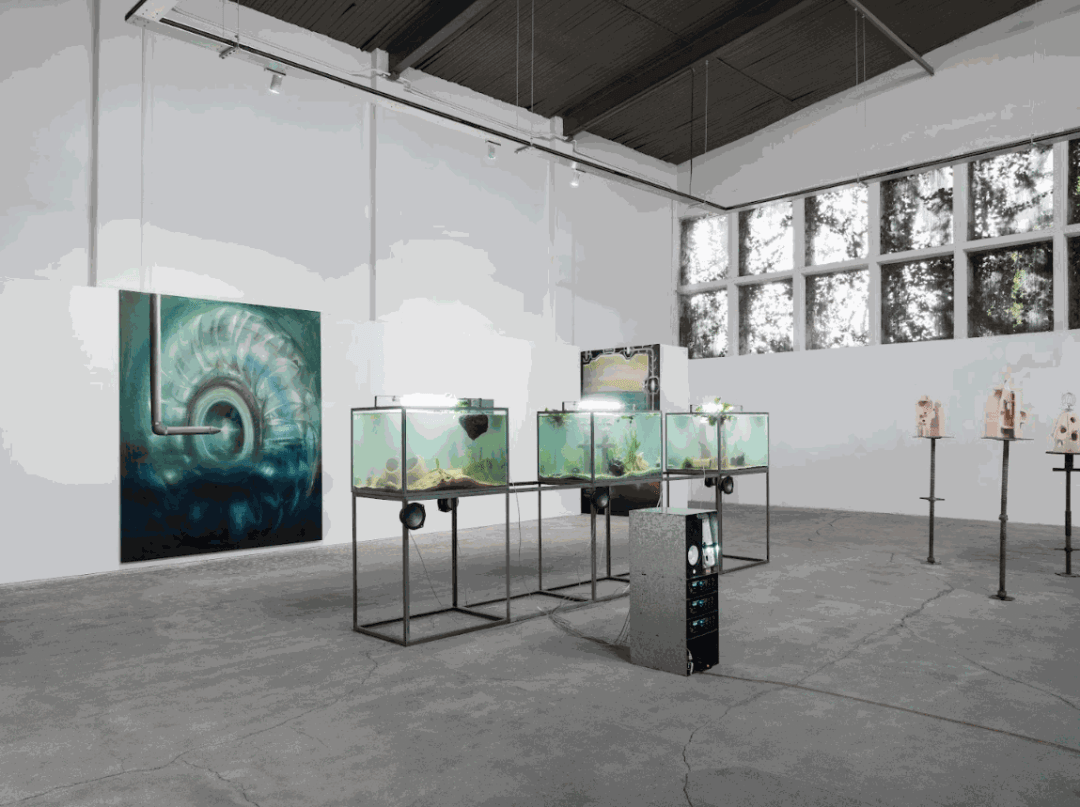Isla Eléctrica
Solo exhibition by Carolina Fusilier, curated by Gaby Cepeda.
“These cans must rid themselves of the obsolescence (and the
artifice) of the industry that produced them... they have to fall sick
in the ground. Fall ill with rust and crust. Finally, only after thirty
four years, do they deserve to disintegrate. This destruction in
nature is painful but necessary if they want to belong to the society
of the worms. After this dismantling into nature, the cans can even
emerge into butterflies...”
— Manoel de Barros, “Cans”, Mémorias Inventadas, 2003.
Deep in the bottom, where light can’t pass through, one can roughly see the roots, the worms in the dark depth. The plates of rock extend from the mountain skirts, the big chunks become medium chunks, then small chunks, until they are soft, fertile particles. Before, the subaquatic cushion held a corn field surrounded by hills. Today, what you see over there are the drowned peaks of those same hills. The flood brought isolation, amongother worse things, and the cables invading the sky promised to reconnect, but we only heard interference. Poor birds, they even stopped talking to each other.
Ptssssssss, grrrrrr, tschhhhhhh, gloogloogloo, that’s the sound of water displacing air, entering every pore in matter to give it a new shape, a new existence. We learned this language when the flood flushed our caves, we learned that the tic-toc of accelerated vitality stays within our own metabolism, we surrendered to mutation. We had to leave behind our earthly dwellings, our city made of rocks, once we thought it eternal, that it would survive our species. We were stunned by the dense air of pollution, the concrete walls and the machines moving like phony clocks. We never believed in that kind of eternity, in that tyrannical expansion of human technology. For them, the river too is a machine, one that must operate and conform to their excessive needs and that’s why they transformed it: they altered its course, readjusted its flow, its temperament, its strength.
And they turned that force, capable of dragging the whole world, into electric frequencies, into lights that erased the stars, into machines feeding other machines in an infinite chain of circuits advancing to the beat of blindness. That’s what happened, the lights brought on the blindness. We realized this because now we see plenty of humans looking disoriented, staring into their perfectly rectangular, glowing rocks. It’s like their spirits left their bodies and they wander aimlessly. We understand their art, the creation of machines that overpower them, with consequences they cannot fathom, consequences that ask permission from nobody. Like a knife splitting a mountain, those are the blades of the turbines cutting the river bed, accelerating its currents, guiding its waters through concrete.
♒︎
Some time after the flood, lungs grew familiar with water and our ancestors realized they could breathe like the fish do, orienting themselves with the fins growing on their necks. That was the beginning of the metabolic community. The first buildings were very ambitious, made with leftovers from the dam, strong metals, cables, finished with rocks, concrete, mud and animal shells. These dwellings were still made to last. We don’t care about that today, we reject durability, permanence, we refute it, we no longer see ourselves in that generation so close to the earthlings. The ideology of our ancestors, and their ancestors before them, were too close to human utopias. Our new places are made with materials meant to dissolve into the river bed and one day we will too. We don’t believe in ruins, because nothing is meant to last.
The river, its mode of existence, taught us to recognize that everything is birthed from energy of constant circulation, that everything that is, including our ways of being, are transitory: the water hauls, dilutes, destroys, irrigates, germinates even that which we thought dead, water revives, like the metal scraps that rain on us. And we laugh at the supposed stability and predictability of human progress. The future is not theirs.
Gaby Cepeda

